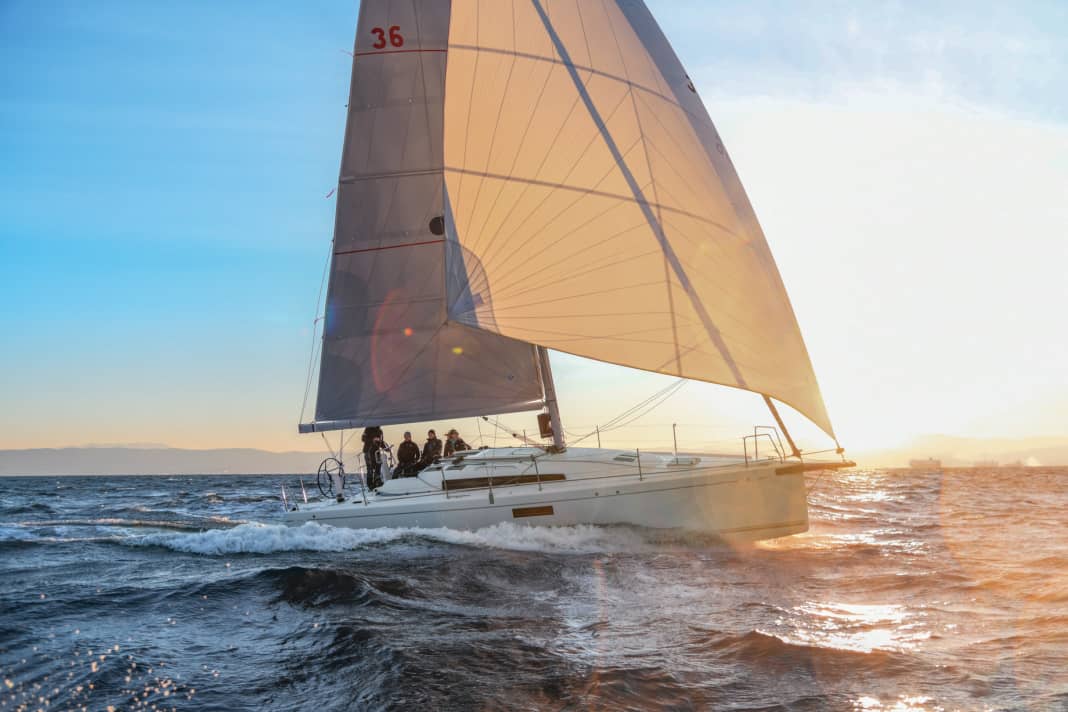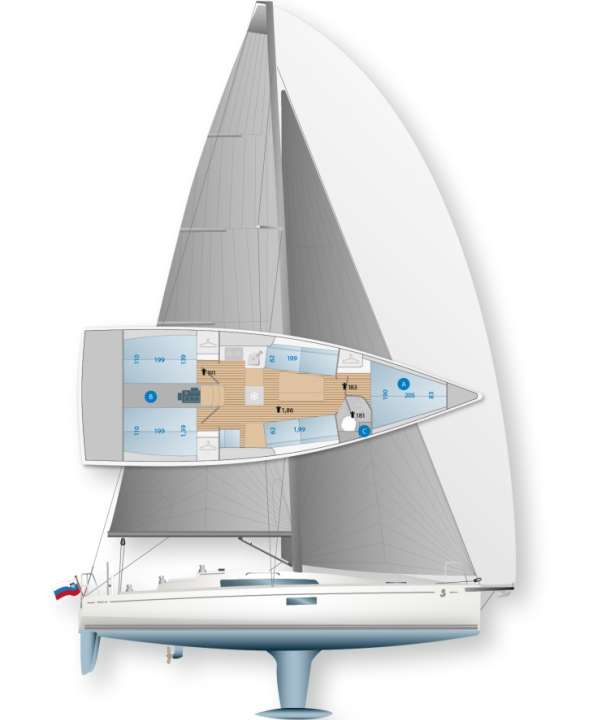





The Slovenian-French co-production First 36 immediately hit the market. Buyer interest is so high that production has been ramped up to three yachts per month. Nevertheless, the boat ordered today will not be available until 2025 at the earliest. It is obviously the special design of the First 36 that has struck a chord with customers.
The First 36 has plenty to offer from both spheres of the performance cruiser segment: Fun and speed on the one hand, volume and comfort on the other. And without any major compromises. Right from the start, it looks harmonious, and for a first model it is also surprisingly well-built. You almost forget that it represents a veritable leap in the model programme for Seascape: more systems, a more elaborate laminate plan, a significantly more complicated structure, higher loads.
However, the resourceful Slovenians were not deterred by the fact that they were breaking new ground with the First 36. Since Beneteau joined the company, they have relocated and modernised their entire production. Even the administration, long located elsewhere, is now fully integrated. Where Europe's largest production facility for wooden coat hangers once stood, on a factory site with rustic industrial charm, the team around co-founder Kristian Hajnsek now builds award-winning sports boats for the world's largest shipyard group.
The division of labour works like this: Beneteau develops and produces the large, more luxurious First models from 44 feet upwards itself. The programme up to 40 feet, on the other hand, is produced entirely by Seascape in Preserje, a suburb of Ljubljana.
The First 36 designed the best
The list of engineers involved in the First 36 reads like a who's who of the yachting world. The design comes from Seascape's regular designer Sam Manuard, who first made a name for himself with the Mini 6.50, then in the Class 40 and is now also helping to shape the Imoca class. Giovanni Belgrano contributed the structural calculations; his Pure Design team works on the latest America's Cups as well as for X-Yachts and many other renowned shipyards. Star architect Lorenzo Argento is responsible for the styling, GigoDesign for the functionality. And then there is the combined expertise of the Beneteau and Seascape teams themselves. All of this together makes the First 36 the production boat with the greatest depth of development currently available.
What is perhaps most surprising in view of this is how restrained the new model is. She doesn't have a dodger over the companionway like all the current Class 40s, Imoca 60s or even the Bente 39, and in contrast to the latest models from Pogo and JPK, her cabin structure with its multi-angled side windows looks almost classic. And even the cockpit appears conventional: instead of the tiller that has characterised Seascape up to now, there are the two steering positions that are common today.
The special features of the First 36
So where are the innovations? What sets First apart from the rest of the market? To understand this, a visit to the shipyard is recommended. This is the best way to understand the special features of the design: How ingenious and at the same time ludicrously complex the XXL puzzle of Corecell foam cores cut to the millimetre is, which gives the sandwich laminate both lightness and strength. How extremely thin the aft edges of the self-built rudders are. How little the bathing platform with honeycomb core weighs (just 8 kilograms!). And how practically every single furniture module also serves to stiffen the hull.
In the end, this results in a displacement of just 4.8 tonnes - a quarter more than the even more extremely designed Pogo 36, but more than a third lighter than the comparably sized Dehler 38. This is the basis for the boat's performance: less weight, more miles.
The First 36 is a high-performance cruiser
The sail carrying capacity of 5.1 places the First 36 above the Dehler 38, Elan E4 or J/112 E. Seascape boss Andraz Mihelin has therefore proclaimed a new category for them and also backs this up with performance parameters: "We are somewhere between racer/cruiser and performance cruiser," he says. He therefore sees the First 36 together with the JPK 39 and Pogo 36 in the "high-performance cruiser" segment.
Whether the term will become established remains to be seen. In fact, the claim of the special class can certainly be understood if you take planing ability as a yardstick. The First 36 needs just 12 knots of wind to leave the mode of a displacer astern under gennaker as well as its own wave system. Then she already overcomes her hull speed; at the stern, the water breaks smoothly between 8.5 and 9 knots of speed. This is a situation that requires more wind, more waves and usually considerably more courage on more conventional yachts in this class.
Gliding is normal with the First 36
The First 36 makes slippery conditions the norm, runs true to course and can be steered down the waves quickly and with surgical precision using the twin rudders.
The test along the Slovenian coast gave an almost even more enchanting impression when it was almost calm. When the anemometer recognised 4 to 5 knots of air movement at the masthead, the water surface remained motionless like a mirror. So it's just a high current. And yet it is enough to propel the boat with Code Zero on a sharp half-wind course almost up to wind speed.
This not only speaks in favour of the lightweight construction, but also for the efficient hull lines. The First 36 benefits here from Sam Manuard's immense wealth of experience. It is a slightly shrunken Class 40 converted into a cruising boat - moderate in comparison to an ocean racer, but with the same DNA.
YACHT then had another opportunity to sail the First 36 in more wind as part of a comparative test of six performance cruisers.
The conditions on the Flensburg Fjord were ideal, with winds of around 10 to 15 knots and occasionally more, with gusts of around 20 knots. After several comparison runs, a fairly clear picture emerged. Downwind, the modern First 36 impressed with its outstanding performance. The Frenchwoman was visibly faster than her competitors, gliding with her huge gennaker from 4 to 5 Beaufort and conjuring up 15 knots of speed on the log in the gusts. It was a real explosion of pleasure - especially for the helmsman. With its two rudder blades, the First 36 was quick to react and steer under pressure in order to easily parry the venomous gusts and many turns on the Flensburg Fjord. If you steer actively, you can relieve the gennaker trimmer of most of the work on the downwind leg. This is not only a lot of fun, but is also an important argument, especially when sailing with a small crew.
Measured values of the First 36





In a direct comparison, the First 36 behaved much more bitchily upwind. The steering system with the double, but smaller rudder blades is set very neutrally, there is hardly any rudder pressure, which is usual for boats of this type and orientation. However, this made it more difficult to steer the boat optimally upwind and required the helmsman's undivided attention to the boat. More work and course correction was required at the wheel than with the boats of the competition.
The First 36 showed hardly any defects
The First 36 also offers a lot of pleasure in other respects. The cockpit is one of the best in the class. The helmsman and crew have plenty of room to manoeuvre and everything is within easy reach. The aluminium mast can be trimmed cleanly using the backstay, as can the genoa using 3D hoist points.
Even below deck, despite its lightweight construction, the First 36 is strikingly attractive and completely comfortable. Of course, small concessions have to be made: There is a lack of storage space in the saloon; but only there. The wet room is a little small. Like the pressurised water pump on the test boat, the Yanmar diesel ran quite audibly. For a boat of this power-to-weight ratio, however, this is a small price to pay, which is certainly outweighed by the marvellous sailing characteristics.

Technical data
- CE design category A
- Hull length 11.00 m
- Total length 11.98 m
- Waterline length 10.66 m
- Width 3.80 m
- Draught/alternative 2.25/1.90 m
- Mast height above WL 17.80 m
- Theoretical hull speed 7.9 knots
- Weight 4.8 tonnes
- Ballast/proportion 1.5 t/32 %
- Mainsail 39.0 m²
- Furling genoa (110 %) 36.0 m²
- Engine (Yanmar) 21 kW/29 hp
- Fuel tank (PVC) 70 litres
- Fresh water tanks (PVC) 2x 100 litres
- Holding tank (PVC) 50 litres
Equipment and prices (as of 6/2022)
- Base price ex shipyard 259.180 €
- Standard equipment included: engine, sheets, railing, navigation lights, battery, compass, cushions, galley/cooker, bilge pump, toilet, fire extinguisher, electric cooler, holding tank with suction system
- At extra cost: sails (main and genoa) €12,800, sailcloth €1,280, anchor with chain €4,430, fenders/mooring €320,
- Antifouling € 7,000, clear sailing handover € 3,200
- Price ready to sail 288.210 €
Surcharge for comfort equipment
- Hole points incl. line adjustment.
- Traveller with line guide incl.
- Electric windlass incl. (with anchor) tube kicker € 660
- Backstay tensioner incl.
- Jumping cleats incl.
- Sprayhood € 2,900
- Teak in the cockpit in preparation
- VHF radio package
- Log, plumb bob, wind display package
- Autopilot package
- Package € 18,200
- Charger incl.
- Shore connection with RCD incl.
- 230 volt socket (one) incl.
- 12-volt socket in the sat nav incl.
- Heating € 5,640
- Pressurised water system incl.
- Hot water boiler € 1,430
- Shower WC room incl.
- Cockpit shower 190 €
- Comfort price 317.230 €
- Guarantee/against osmosis 7/7 years
Shipyard
- Beneteau/Seascape, 85800 Saint-Gilles-Croix-de-Vie (FRA) www.beneteau.com
Distribution
YACHT rating
The First 36 sails fantastically without being extreme anywhere. And it feels far more cosy below deck than you would expect from its smaller sisters. All in all, this makes for a pretty good performance cruiser. If you can get one.
Design and concept
- +High-quality GRP work
- + Low weight for volume
- + Timeless hull/deck design
- - High price level
Sailing performance and trim
- + Easily accessible potential
- + Very good performance values
- + Extremely efficient steering gear
- + Top cockpit ergonomics
Living and finishing quality
- + Light, modern ambience
- + Comfortable berth dimensions
- - Small wet room
- - Too little storage space in the lounge
Equipment and technology
- + Well dimensioned fittings
- + Plenty of storage space on deck
- + Useful option packages
- - Long delivery time

